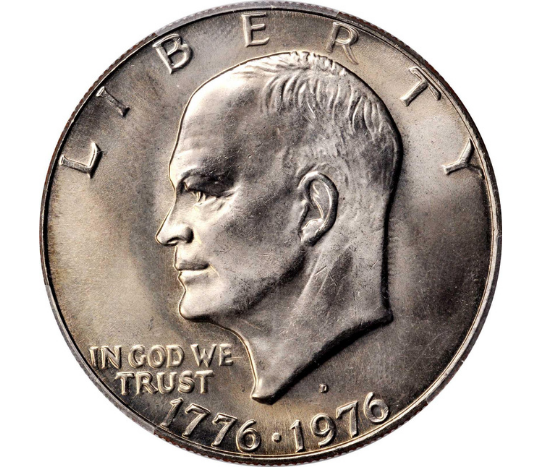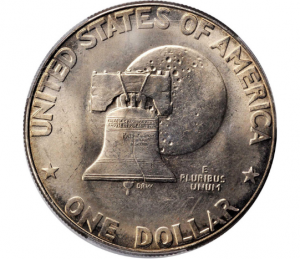
The 1976-D Type I Eisenhower Dollar is the Professional Grading Service’s (PCGS) Coin of the Month (PCGS MS67).
The Eisenhower dollar has become a popular coin as of late, with more and more collectors embracing this modern dollar, the biggest of the nation’s clad coins and the last of the circulating large-size dollar coinage. When it comes to Ike dollars, many folks seem to have the impression that while the coin has its numismatic merits, it’s still just a common series with little to offer beyond an affordable exercise in set building. Au contraire!
All of the circulating clad Eisenhower dollars are scarce in MS65 and generally rare in MS66 or higher. Why? These large coins jangled and jingled in mint bags throughout their journey from the mint, where they weren’t necessarily handled with exceptional care, to begin with. Large, heavy coins tend to acquire numerous nicks and scratches; it’s a point rooted in basic physics that is well recognized when discussing Morgan dollars but something that an astounding number of collectors and dealers don’t think about when courting Ikes.
The 1976 Bicentennial dollars saw huge mintages, though the so-called Type I reverse – which carries inscriptions with blocky, sans-serif font – is much scarcer than Type II examples, which offer lettering with more refined, serifed contours. Still, a total of 21,048,710 Eisenhower dollars rolled out of the United States Mint bearing the distinctive 1776-1976 dual-dating feature on the obverse and Type I reverse, and that’s a respectable sum, to say the least.
Yet, only a small fraction of those 21 million-plus pieces survived in gem grades, and just 13 saw surfaces so preserved well enough to earn an MS67 grade from Professional Coin Grading Service. One such specimen landed a respectable final bid of $9,600 in a November 2020 Stack’s Bowers Galleries auction, serving as a true testament to just how rare and desirable high-end Eisenhower dollars really are.
Coin Grading
Grade refers to a coin’s level of preservation: how many nicks or scratches or other imperfections it has. Coins are graded on a scale of one to 70, with higher numbers signifying higher grades. One represents a coin that is so well worn that it’s barely identifiable as to its type. 70 represents a perfect coin: a coin that when viewed under a five-power magnifying glass has no visible imperfections.
60 through 70 represent the Mint State (MS) grades. A coin graded MS-60 can have so many nicks and scratches and flaws that it might look as if Godzilla used it as a teething ring. MS-65 is the industry standard for “Gem.” MS-66 through MS-69 are the near-flawless super-grade or wonder coin assignations. With each grade level above MS-66, the value might double or triple.
Grade names are used in addition to numerical grades. In ascending order, these word grades are About or Almost Good; Good; Very Good; Fine; Very Fine; Extra or Extremely Fine; About or Almost Uncirculated; and Mint State.
A Proof is not a special Mint State coin. Proof refers to a method of manufacture, not a grade. Although Proof coins are struck using specially polished dies and specially selected planchets (metal discs) to assure a chromium-like brilliance, they can circulate or be spent. Proofs are also graded on the one through 70 scale. A Proof coin grading less than Proof-60 is called an “impaired Proof.”
The Professional Coin Grading Service (PCGS) and the Numismatic Guaranty Company (NGC) are the coin field’s highest-volume authentication and grading services. PCGS and NGC encapsulate coins in sonically-sealed hard plastic holders that are tamper-evident. Most buyers of valuable coins demand only coins that have been certified by leading grading services. These services offer guarantees of authenticity and grade, and their coins often trade sight unseen based on their certified grade.
*Images courtesy of Legend Rare Coin Auctions.













